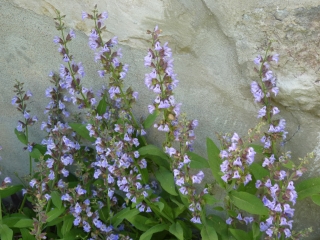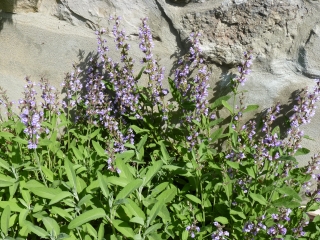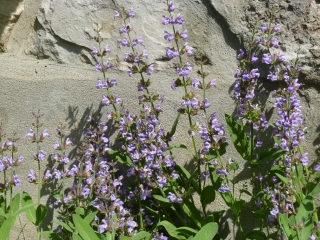home |
avr microcontroller & DIY electronics |
toolbox |
science club |
tuxtalk |
photos |
e-cards |
Online-Shop

no preservatives added blog |
computer and graphics corner |
herbal treasure chest |
splash into math |
stardust |
periodic table
sage (salvia officinalis)

Sage is said to be the herb of wisdom and immortality.
how to grow:
Sage is easy to grow from seeds. It is a perennial and hardy in US zones 4-9. Sage plants like lots of sun and usually you don't need to water them. They are not drought resistant however. June is the time when they are in bloom and bees and butterflies love them.
medicinal properties
Sage is good to drink as tea when you have a cold, a sore throat, nasal congestion, laryngitis, tonsillitis or the flu. You can also take a sage drop for relief. Guido has a nice recipe for sage-honey lozenges.

In addition it is known to help dry up milk flow of breast feeding mothers who can take the herb if they want to stop breast feeding.
It is also known to regulate or bring on menstruation. I once drank a tea made from fresh sage, thyme and ginger when I had a bad cold and suddenly got my period even though I wasn't due for over a week. While ginger is known to have such effects I don't think it was the ginger alone but the combination of ginger and sage (I believe the thyme was harmless). So remember sage really is a strong herb.
It is also said to help reduce sweating when taken as tea.
It has been discovered that sage improves brain nerve transmission by blocking AChE (acetylcholinesterase) from breaking down acetylcholine into inactive choline and acetate and thus keeping the compound longer in the synapse.
Therefore sage has a positive effect on memory and attention and might even help with Alzheimer and other dementia diseases.
Externally sage is anti-inflammatory and antioxidant. (Antioxidants may prevent or delay some types of cell damage). It can be used for burns or wounds.
To make a tea or infusion take 1-2 teaspoons for 1 cup of boiling water and let it steep for 10 minutes. Some say to drink no more than 1 cup a day while others recommend the usual 3 cups.
When you harvest the leaves let them dry in the shade where it is less than 34°C.
cautions and possible side effects:
- Sage contains thujone and therefore can cause symptoms of poisoning, convulsions, dizziness, hot flashes or a rapid heartbeat. Don't drink sage in excess or over long periods of time (consume it in moderation, don't drink it for more than 14 days per months)
- Avoid during pregnancy as sage can stimulate the muscles of the uterus and the thujone can bring on menstruation flow.
- Don't use it when breastfeeding as it can reduce the flow of milk.
- Avoid sage if you have epilepsy.

further reading:
- A Russian Herbal: Traditional Remedies for Health and Healing by Igor Vilevich Zevin, (Healing Arts Press (1997),ISBN-13: 978-0892815494)
- herbal medicine - trends and traditions by Charles W. Kane, (Lincoln Town Pr; 1 edition (May 1 2009), ISBN-13: 978-0977133321)
- Rosemary Gladstar's Medicinal Herbs: A Beginner's Guide: 33 Healing Herbs to Know, Grow, and Use by Rosemary Gladstar, ( Storey Publishing, LLC (April 10 2012),ISBN-13: 978-1612120058)
- The Herbal Handbook: A User's Guide to Medical Herbalism by David Hoffmann, ( Healing Arts Press; 3rd Edition, Revised Edition of The Herb User's Guide edition (Feb. 1 1998), ISBN-13: 978-0892817825)
- The Green Pharmacy Herbal Handbook: Your Comprehensive Reference to the Best Herbs for Healing Paperback by James A. Duke, (Rodale Books (Nov. 18 2000), ISBN-13: 978-1579541842)
- 20,000 Secrets of Tea: The Most Effective Ways to Benefit from Nature's Healing Herbs by Victoria Zak, (Bantam Doubleday Dell Publishing Group Inc (Dec 1 1999), ISBN-13: 978-0440235293)
Copyright © 2004-2025 Katja Socher, tuxgraphics.org




